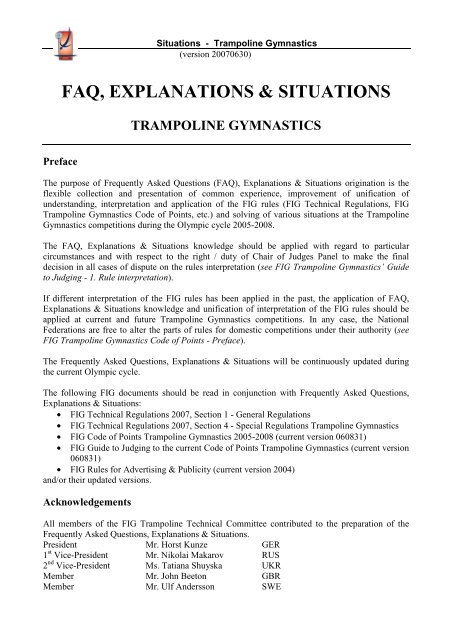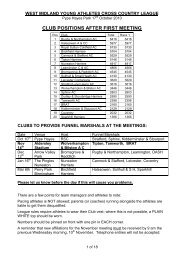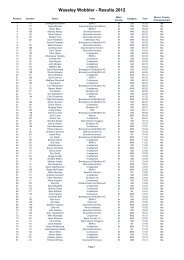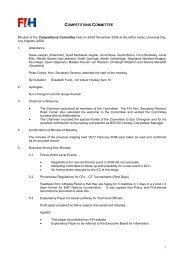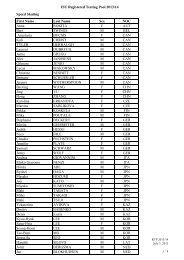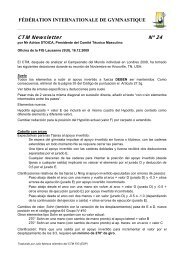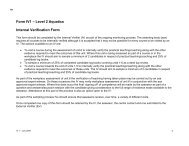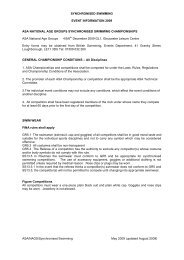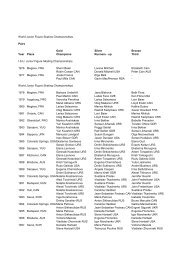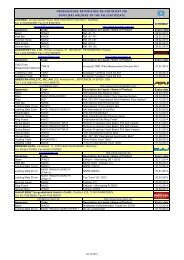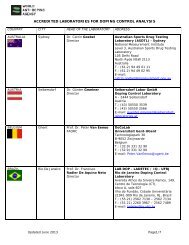faq, explanations & situations trampoline gymnastics - FIG
faq, explanations & situations trampoline gymnastics - FIG
faq, explanations & situations trampoline gymnastics - FIG
Create successful ePaper yourself
Turn your PDF publications into a flip-book with our unique Google optimized e-Paper software.
Situations - Trampoline Gymnastics(version 20070630)FAQ, EXPLANATIONS & SITUATIONSTRAMPOLINE GYMNASTICSPrefaceThe purpose of Frequently Asked Questions (FAQ), Explanations & Situations origination is theflexible collection and presentation of common experience, improvement of unification ofunderstanding, interpretation and application of the <strong>FIG</strong> rules (<strong>FIG</strong> Technical Regulations, <strong>FIG</strong>Trampoline Gymnastics Code of Points, etc.) and solving of various <strong>situations</strong> at the TrampolineGymnastics competitions during the Olympic cycle 2005-2008.The FAQ, Explanations & Situations knowledge should be applied with regard to particularcircumstances and with respect to the right / duty of Chair of Judges Panel to make the finaldecision in all cases of dispute on the rules interpretation (see <strong>FIG</strong> Trampoline Gymnastics’ Guideto Judging - 1. Rule interpretation).If different interpretation of the <strong>FIG</strong> rules has been applied in the past, the application of FAQ,Explanations & Situations knowledge and unification of interpretation of the <strong>FIG</strong> rules should beapplied at current and future Trampoline Gymnastics competitions. In any case, the NationalFederations are free to alter the parts of rules for domestic competitions under their authority (see<strong>FIG</strong> Trampoline Gymnastics Code of Points - Preface).The Frequently Asked Questions, Explanations & Situations will be continuously updated duringthe current Olympic cycle.The following <strong>FIG</strong> documents should be read in conjunction with Frequently Asked Questions,Explanations & Situations:• <strong>FIG</strong> Technical Regulations 2007, Section 1 - General Regulations• <strong>FIG</strong> Technical Regulations 2007, Section 4 - Special Regulations Trampoline Gymnastics• <strong>FIG</strong> Code of Points Trampoline Gymnastics 2005-2008 (current version 060831)• <strong>FIG</strong> Guide to Judging to the current Code of Points Trampoline Gymnastics (current version060831)• <strong>FIG</strong> Rules for Advertising & Publicity (current version 2004)and/or their updated versions.AcknowledgementsAll members of the <strong>FIG</strong> Trampoline Technical Committee contributed to the preparation of theFrequently Asked Questions, Explanations & Situations.President Mr. Horst Kunze GER1 st Vice-President Mr. Nikolai Makarov RUS2 nd Vice-President Ms. Tatiana Shuyska UKRMember Mr. John Beeton GBRMember Mr. Ulf Andersson SWE
Situations - Trampoline Gymnastics(version 20070630)gymnast, the coach or delegation official, enabling for immediate correction(s) (see <strong>FIG</strong>Trampoline Gymnastics Code of Points - 7. Competition Cards & 22. Duties of the Judges forDifficulty).TRA, TUM, DMT: How is the national identity presented at competitions in TrampolineGymnastics?All competitors representing their country or national federation who participate in competitionmust wear the national emblem or the federation emblem on their competition attire asidentification of their country. The only exception is if the entire uniform is designed in the nationalcolours and portrays clearly the national identity.This identification can be in the form of a badge (sewn on) the name of the country or federationwritten out in full or abbreviated, or in the form of a crest in their national colours on the leotard orsinglet.The emblems may appear as follows:– Men’s singlet : anywhere on the breast/sternum area according to good design and taste– Women’s leotard: sternum, breast or on either sleeve.The badge / emblem / crest of the country or <strong>gymnastics</strong> federation may not exceed the maximumoverall area of 80 sq. cm and minimum overall area of 30 sp. cm.(see <strong>FIG</strong> Rules for Advertising & Publicity - Section 1 - 3.8 National Emblem or FederationEmblem)Consequently, the same emblem (national identity presentation) must be worn uniformly by allmembers of team or synchronised pair.At <strong>FIG</strong> events: If the national/federation emblem is not worn, or does not adhere to the appropriate<strong>FIG</strong> regulation, a penalty of 0.1 points will be deducted from the total score of any of theroutines/passes where the violation occurred. (see <strong>FIG</strong> Trampoline Gymnastics Code of Points - 6.Dress for Gymnasts and Spotters & 20. Duties of the Chair of Judges Panel)TRA, TUM, DMT: What will happen, if the spotter violates the dress requirements inTrampoline Gymnastics?The Chair of the Judges Panel can remove him / her off the competition area. Especially thefollowing are not accepted: sandals, jeans, slippers, shorts, Bermudas, shirts, caps, glasses on thehead, etc. This can be applied for both the official and own spotters. (see <strong>FIG</strong> TrampolineGymnastics Code of Points - 6. Dress for Gymnasts and Spotters & 20. Duties of the Chair ofJudges Panel).TRA: Do the Judges for Synchronisation evaluate also the differences during each element(e.g. if both gymnasts in the pair do the opening at the same time) at the Trampolinesynchronised competitions?No, the Judges for Synchronisation evaluate the landing differences in each landing in a routineonly. They are also subtracting the deduction for different out-bounce or standing still after the 10 thelement from the maximum mark on the instruction of the Chair of Judges Panel (see <strong>FIG</strong>Trampoline Gymnastics Code of Points - 24. Duties of the Judges for Synchronisation).TRA, TUM, DMT: Are there any reserve gymnasts / pairs / teams allowed for the Finals inTrampoline Gymnastics?Yes. If a gymnast or pair has to withdraw from the Final in competitions under <strong>FIG</strong> authoritybecause of injury or illness, the next placed gymnast / pair from the Qualifying Round will beallowed to start in the Final. Even if the reserve gymnasts / pairs were published, the priority will be
Situations - Trampoline Gymnastics(version 20070630)given to the next placed gymnast / pair from the affected country, if he / it was ranked before thepublished reserve in the Qualifying Round. (see <strong>FIG</strong> Technical Regulations - Section 4 - Reg. 1Principles for the Competition Programme).TRA, TUM, DMT: When is the twist (1/2 twist) considered as a completed element inTrampoline Gymnastics?For the decision on how many 1/2 twists the gymnast has completed the Judges are looking at theposition of the feet at landing. Feet rotation of more than 1/4 twist (90°) is considered a 1/2 twist,feet rotation of more than 3/4 twist (270°) is considered a 1/1 twist, etc. (see <strong>FIG</strong> TrampolineGymnastics Code of Points - 18. Scoring)TRA, TUM, DMT: Can earrings be worn in Trampoline Gymnastics, if they are taped?No, only the rings without gemstones may be worn if they are taped. (see <strong>FIG</strong> TrampolineGymnastics Code of Points - 6. Dress for Gymnasts and Spotters)Part II - EXPLANATIONSElements with counting difficulty in the first routine(TRA - at <strong>FIG</strong> events)(see <strong>FIG</strong> Trampoline Gymnastics Code of Points - 5. Routines and 7. Competition cards)The first routine in the Qualifying Round includes 2 elements with counting difficulty.The elements with counting difficulty must be written down with their difficulty value and markedwith an asterisk (*) in the competition card.The difficulty of the elements performed on the positions marked by asterisk in the competitioncard will be added to the to the execution score for the first routine. Total score for the first routine= execution score (+ synchronisation score) + difficulty score of the elements with countingdifficulty - penalties.Note: The changes, repetitions and missing requirements / elements are subject to the respectiveadditional deductions in the first routine.In the second routine none of the elements already counted for difficulty in the first routine can berepeated, otherwise the difficulty of these elements will not be considered for calculation in thesecond routine.Example:Competition cardPerformed first routine1. 12 - - 1 < * 1.8 1. 12 - - 1 < * 1.82. 4 - / 2. 4 - /3. 4 1 / 3. 4 1 /4. 4 2 4. 4 25. 4 3 5. 4 36. 4 - < 6. 4 -
Situations - Trampoline Gymnastics(version 20070630)− difficulty score 3.0 pts. will be counted for the first routine− 12 - - 1 < and/or 8 - - < can not be repeated in the second routine otherwise the difficulty ofthese elements will not be counted in the second routine− additional deduction 0.2 pts. for change to the element written in the competition card willbe applied by the Judges for Execution on the instruction of the Chair of the Judges Panel inthe first routine− the changes, repetitions and missing requirements / elements are checked and notified to theChair of the Judges Panel by the Judges for Difficulty.Tie-break rules(TRA, TUM, DMT)(see <strong>FIG</strong> Technical Regulations – Section 4 – Reg. 4.4 Programme)The following tie-break rules apply in the individual classification:a) in the Qualifying Round the criteria are based on the second routine/pass :1. higher total score of the second routine/pass (execution score + difficulty score - penalties)2. higher execution score in the second routine/pass (3 middle execution judges marks)3. higher total of all 5 execution judges marks in the second routine/pass4. higher total of the 4 highest execution judges marks in the second routine/pass5. and so on until the tie is brokenb) in the Finals the criteria are based on the final routine/second final pass :1. higher total score of the second final pass (at Tumbling and Double Mini-Trampolinecompetitions only) (execution score + difficulty score - penalties)2. higher execution score in the final routine/second final pass (3 middle execution judgesmarks)3. higher total of all 5 execution judges marks in the final routine/ second final pass4. higher total of the 4 highest execution judges marks in the final routine/ second final pass5. and so on until the tie is broken(TRA: if the winner is decided by the overall number of points the following criteria will beused as a first step: higher total score of the final routine = execution score + difficulty score -penalties)The following tie-break rules are applied in the team classification:a) in the Qualifying Round the criteria are based on the sum of the total scores of the secondroutines/passes (execution score + difficulty score - penalties) :1. higher sum of 3 highest total scores of the second routine/pass2. higher sum of 2 highest total scores of the second routine/pass3. higher highest total score of the second routine/passb) in the Finals the criteria are based on the result of the Qualifying Round :1. higher ranking from the Qualifying RoundTRA: the following tie-break rules are applied in the synchronised classification in the Trampolinecompetition:a) in the Qualifying Round the criteria are based on the second routine and synchronisation :1. higher total score of the second routine (execution score + synchronisation score + difficultyscore - penalties)2. higher score for synchronisation in the second routine (1 middle synchronisation judgesmark multiplied by 2)
Situations - Trampoline Gymnastics(version 20070630)3. higher total of the scores for synchronisation in the first plus second routineb) in the Finals the criteria are based on the synchronisation and result of the Qualifying Round :1. higher score for synchronisation in the final (1 middle synchronisation judges markmultiplied by 2)2. higher total score from the Qualifying Round(If the winner is decided by the overall number of points the following criteria will be used as afirst step: higher total score of the final routine = execution score + synchronisation score +difficulty score - penalties)Related questions:TRA, TUM, DMT: What happens if the tie-break rules were applied and there is still tie inthe Trampoline Gymnastics?If all prescribed tie-break rules were applied and there is still a tie, the gymnasts / teams / pairs willobtain the same ranking.TRA, TUM, DMT: What tie-break criteria will be applied if the winner is decided by theoverall number of points (first + second + final routine) and there is a tie?The following criteria will be used as the first step:TRA Individual: The gymnast with the higher final score of the final routine (execution score +difficulty score - penalties).TUM, DMT individual: The gymnast with the higher total score of the second final pass (executionscore + difficulty score - penalties).TRA synchronised: The pair with the higher total score of the final routine (execution score +synchronisation score + difficulty score - penalties).TRA, TUM, DMT teams: The team with the higher ranking from the Qualifying Round.TRA: What will be the ranking if there are 2 gymnasts with the equal total score after theQualifying Round at the Trampoline Competition as follows:qualification second routine execution difficulty penalty- Gymnast A 64.70 36.50 ~ 8.3 8.0 8.1 7.9 7.7 ~ 12.5 ~ 0.0- Gymnast B 64.70 36.50 ~ 8.4 8.1 8.2 8.0 7.9 ~ 12.5 ~ 0.3Gymnast B will be ranked ahead of Gymnast A (he / she have the higher tie-break rules result in thesecond step):A B1. total score of the second routine 36.50 36.502. execution score in the second routine 24.00 24.303. total of all 5 execution judges marks in the second routine 40.00 40.604. total of the 4 highest execution judges marks in the second routine 32.30 32.705. total of the 3 highest execution judges marks in the second routine 24.40 24.706. total of the 2 highest execution judges marks in the second routine 16.40 16.607. highest execution judges mark in the second routine 8.30 8.40
Situations - Trampoline Gymnastics(version 20070630)− the gymnasts performed the same 7 th and 10 th element (repetition)Competition cardPerformed first routine1. 8 - 1 < * 1.3 1. 8 - 1 < * 1.32. 4 - / 2. 4 - /3. 4 1 / 3. 4 1 /4. 4 2 4. 4 25. 4 3 5. 4 36. 4 - < 6. 4 -


